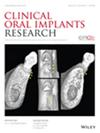Evaluation of a Gel Loaded With M101 on Bone and Peri‐Implantitis Healing: An Experimental In Vivo Study
IF 5.3
1区 医学
Q1 DENTISTRY, ORAL SURGERY & MEDICINE
引用次数: 0
Abstract
ObjectivesThe aim of this study was to evaluate the effect of M101 gel in bone and peri‐implantitis healing and its safety of use.Materials and MethodsM101 gel and solution (1 g/L) were evaluated in four different models: (i) human osteoblast culture; (ii) mouse calvarial defect; (iii) extraction model in dogs; (iv) peri‐implantitis model in dogs. M101 cytocompatibility was evaluated in osteoblasts, and expression of ALP, Runx2, and BMP‐2 was determined. Calvarial defect was induced in mice by bone drilling, and healing was evaluated after 5 weeks. In dogs, peri‐implantitis was treated by non‐surgical and surgical approaches with or without M101 gel application. Analyses were performed after 2 months. Socket healing was evaluated by micro‐CT after tooth extraction. Local and systemic responses were evaluated after gel administration and intravenous injection.ResultsThe cytocompatibility of M101 was confirmed in osteoblasts, and ALP, Runx2, and BMP‐2 gene expression was increased after exposure (负载M101凝胶对骨和种植体周围炎愈合的评价:一项实验体内研究
目的评价M101凝胶在骨和种植体周围炎愈合中的作用及其使用安全性。材料和方法sm101凝胶和溶液(1 g/L)在四种不同的模型中进行评估:(i)人成骨细胞培养;(ii)小鼠颅骨缺损;(iii)犬类提取模型;(iv)犬种周围炎模型。在成骨细胞中评估M101的细胞相容性,并检测ALP、Runx2和BMP‐2的表达。采用骨钻孔法诱导小鼠颅骨缺损,5周后观察愈合情况。在犬中,种植体周围炎通过非手术和手术途径治疗,有或没有使用M101凝胶。2个月后进行分析。拔牙后用micro - CT评估牙槽愈合情况。凝胶给药和静脉注射后评估局部和全身反应。结果M101在成骨细胞中具有细胞相容性,暴露后ALP、Runx2、BMP‐2基因表达增加(p < 0.05)。在小鼠中,M101凝胶处理组颅骨骨缺损愈合比未处理组多1.6倍(p < 0.001)。在提取模型中,局部应用M101凝胶和全身给药均未引起免疫反应。在犬种植体周围炎模型中,与不使用M101凝胶的非手术治疗相比,M101凝胶作为辅助治疗的非手术治疗可改善PiPD降低(p < 0.05)。当作为手术治疗的辅助手段时,没有观察到差异。结论m101可能是一种安全而有趣的佐剂,可促进种植体周围炎的骨愈合和非手术治疗。
本文章由计算机程序翻译,如有差异,请以英文原文为准。
求助全文
约1分钟内获得全文
求助全文
来源期刊

Clinical Oral Implants Research
医学-工程:生物医学
CiteScore
7.70
自引率
11.60%
发文量
149
审稿时长
3 months
期刊介绍:
Clinical Oral Implants Research conveys scientific progress in the field of implant dentistry and its related areas to clinicians, teachers and researchers concerned with the application of this information for the benefit of patients in need of oral implants. The journal addresses itself to clinicians, general practitioners, periodontists, oral and maxillofacial surgeons and prosthodontists, as well as to teachers, academicians and scholars involved in the education of professionals and in the scientific promotion of the field of implant dentistry.
 求助内容:
求助内容: 应助结果提醒方式:
应助结果提醒方式:


